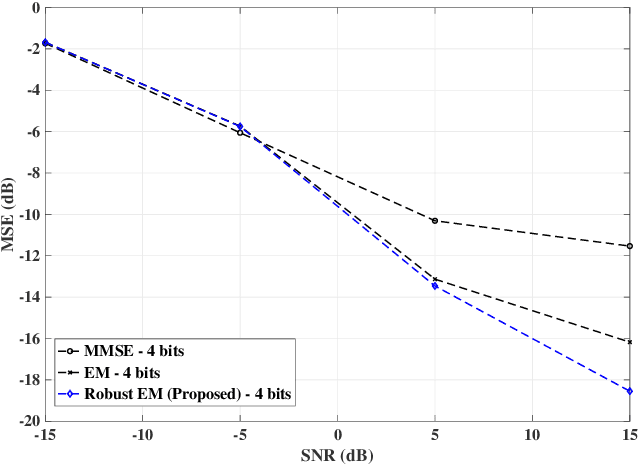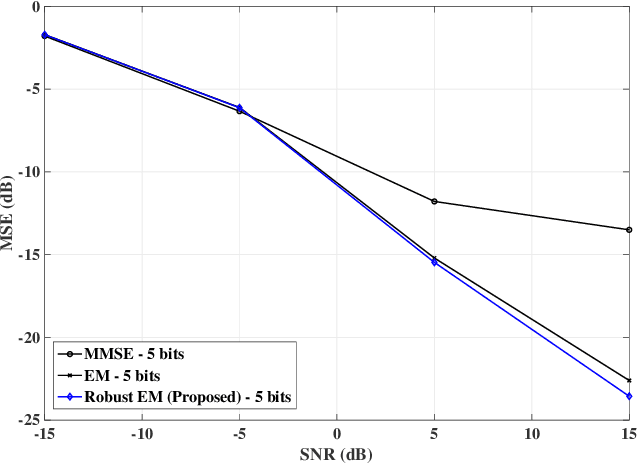Evangelos Vlachos
Receiving RISs: Enabling Channel Estimation and Autonomous Configuration
Jun 12, 2025Abstract:This chapter focuses on a hardware architecture for semi-passive Reconfigurable Intelligent Surfaces (RISs) and investigates its consideration for boosting the performance of Multiple-Input Multiple-Output (MIMO) communication systems. The architecture incorporates a single or multiple radio-frequency chains to receive pilot signals via tunable absorption phase profiles realized by the metasurface front end, as well as a controller encompassing a baseband processing unit to carry out channel estimation, and consequently, the optimization of the RIS reflection coefficients. A novel channel estimation protocol, according to which the RIS receives non-orthogonal training pilot sequences from two multi-antenna terminals via tunable absorption phase profiles, and then, estimates the respective channels via its signal processing unit, is presented. The channel estimates are particularly used by the RIS controller to design the capacity-achieving reflection phase configuration of the metasurface front end. The proposed channel estimation algorithm, which is based on the Alternating Direction Method of Multipliers (ADMM), profits from the RIS random spatial absorption sampling to capture the entire signal space, and exploits the beamspace sparsity and low-rank properties of extremely large MIMO channels, which is particularly relevant for communication systems at the FR3 band and above. Our extensive numerical investigations showcase the superiority of the proposed channel estimation technique over benchmark schemes for various system and RIS hardware configuration parameters, as well as the effectiveness of using channel estimates at the RIS side to dynamically optimize the possibly phase-quantized reflection coefficients of its unit elements.
Time-Domain Channel Estimation for Extremely Large MIMO THz Communications with Beam Squint
Oct 23, 2023



Abstract:In this paper, we study the problem of extremely large (XL) multiple-input multiple-output (MIMO) channel estimation in the Terahertz (THz) frequency band, considering the presence of propagation delays across the entire array apertures, which leads to frequency selectivity, a problem known as beam squint. Multi-carrier transmission schemes which are usually deployed to address this problem, suffer from high peak-to-average power ratio, which is specifically dominant in THz communications where low transmit power is realized. Diverging from the usual approach, we devise a novel channel estimation problem formulation in the time domain for single-carrier (SC) modulation, which favors transmissions in THz, and incorporate the beam-squint effect in a sparse vector recovery problem that is solved via sparse optimization tools. In particular, the beam squint and the sparse MIMO channel are jointly tracked by using an alternating minimization approach that decomposes the two estimation problems. The presented performance evaluation results validate that the proposed SC technique exhibits superior performance than the conventional one as well as than state-of-the-art multi-carrier approaches.
Millimeter Wave Channel Estimation for Lens based Hybrid MIMO with Low Resolution ADCs
Nov 15, 2022


Abstract:The high path loss associated with millimeter wave (mmWave) frequency communication can be compensated by large scale antenna arrays such as multiple-input multiple-output (MIMO) systems. The hybrid beamforming architecture which uses fewer radio frequency chains is implemented to reduce power consumption and hardware complexity, while still supporting multi-stream communication. We propose an efficient expectation-maximization (EM)-based mmWave channel estimator for a lens-based hybrid MIMO system with low resolution sampling at the receiver. The lens-based beamformer is investigated to provide increased antenna gain and reduced implementation complexity as the conventional beam selection network is excluded. Low resolution sampling at the analog-to-digital converters is implemented for reduced power consumption. The proposed solution with a robust maximum a posteriori estimator based on the EM algorithm performs better than the conventional EM approach and minimum mean square error baselines in medium to high signal-to-noise ratio regions.
Flexible Hybrid Beamforming for Spectrally Efficient 6G Joint Radar-Communications
Nov 15, 2022



Abstract:Joint radar-communications (JRC) benefits from multi-functionality of radar and communication operations using same hardware and radio frequency (RF) spectrum resources. Thus JRC systems possess very high potential to be employed into the sixth generation (6G) standards. This paper designs a flexible beamformer for multiple-input multiple output (MIMO) JRC with maximized spectral efficiency (SE). Hybrid beamforming is implemented which constitutes lesser number of RF chains than number of transmitter antennas. We jointly express JRC rate with communication and radar entities including a weighting factor which depicts the dominance of one operation over the other. The joint-SE based proposed method optimally selects the number of RF chains with flexible hynrid beamforming design. Furthermore, when the communication operation takes place the proposed method takes into account the interference occurring from the radar operation and vice-versa. Fractional programming based selection procedure is used for flexible beamforming and optimal number of RF chains while considering interference of each operation. Simulation results are presented and compared with different baselines to show effectiveness of the proposed flexible hybrid beamforming method.
Covariance-Based Hybrid Beamforming for Spectrally Efficient Joint Radar-Communications
Nov 15, 2022Abstract:Joint radar-communications (JRC) is considered to be a vital technology in deploying the next generation systems, since its useful in decongestion of the radio frequency (RF) spectrum and utilising the same hardware resources for dual functions. Using JRC systems for dual function generates interference between both the operations which needs to be addressed in future standardization. Furthermore, JRC systems can be advanced by deploying hybrid beamforming which implements fewer number of RF chains than the number of transmit antennas. This paper designs a robust hybrid beamformer for minimizing the interference of a JRC transmitter via RF chain selection resulting into mutual information maximization. We consider a weighted mutual information for the dual function JRC system and implement a common analog beamformer for both the operations. The mutual information maximization problem is formulated which is non-convex and difficult to solve. The problem is simplified to convex form and solved using Dinkelbach approximation abased fractional programming. The performance of the optimal RF selection based proposed approach is evaluated, compared with baselines and its effectiveness is inferred via numerical results.
 Add to Chrome
Add to Chrome Add to Firefox
Add to Firefox Add to Edge
Add to Edge